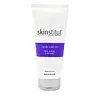What's inside
What's inside
 Key Ingredients
Key Ingredients

 Benefits
Benefits

 Concerns
Concerns

 Ingredients Side-by-side
Ingredients Side-by-side

Water
Skin ConditioningGlycerin
HumectantGlycolic Acid
BufferingSucrose
HumectantHydrated Silica
AbrasivePolyglyceryl-10 Dipalmitate
EmollientPropanediol
SolventLactic Acid
BufferingSodium Cocoyl Isethionate
CleansingPolyacrylate Crosspolymer-6
Emulsion StabilisingSodium Hydroxide
BufferingSodium Lactate
BufferingAcrylamide/Sodium Acryloyldimethyltaurate Copolymer
Emulsion StabilisingCitrus Limon Peel Powder
AbsorbentCitrus Limon Fruit Extract
MaskingOcimum Sanctum Leaf Extract
Skin ConditioningChamomilla Recutita Flower Extract
MaskingGlycyrrhiza Glabra Root Extract
BleachingSaccharum Officinarum Extract
MoisturisingCitrus Aurantifolia Peel Extract
CleansingSantalum Album Extract
CleansingCitrus Limon Peel Oil
MaskingCitrus Aurantium Bergamia Peel Oil
Leuconostoc/Radish Root Ferment Filtrate
AntimicrobialCoconut Acid
CleansingSodium Riboflavin Phosphate
Skin ConditioningDimethylhydroxy Furanone
MaskingIsohexadecane
EmollientPolysorbate 80
EmulsifyingSodium Isethionate
CleansingSorbitan Oleate
EmulsifyingTriethyl Citrate
MaskingVanillin
MaskingPentaerythrityl Tetra-Di-T-Butyl Hydroxyhydrocinnamate
AntioxidantCaprylyl Glycol
EmollientPhenoxyethanol
PreservativeLimonene
PerfumingLinalool
PerfumingCitral
PerfumingWater, Glycerin, Glycolic Acid, Sucrose, Hydrated Silica, Polyglyceryl-10 Dipalmitate, Propanediol, Lactic Acid, Sodium Cocoyl Isethionate, Polyacrylate Crosspolymer-6, Sodium Hydroxide, Sodium Lactate, Acrylamide/Sodium Acryloyldimethyltaurate Copolymer, Citrus Limon Peel Powder, Citrus Limon Fruit Extract, Ocimum Sanctum Leaf Extract, Chamomilla Recutita Flower Extract, Glycyrrhiza Glabra Root Extract, Saccharum Officinarum Extract, Citrus Aurantifolia Peel Extract, Santalum Album Extract, Citrus Limon Peel Oil, Citrus Aurantium Bergamia Peel Oil, Leuconostoc/Radish Root Ferment Filtrate, Coconut Acid, Sodium Riboflavin Phosphate, Dimethylhydroxy Furanone, Isohexadecane, Polysorbate 80, Sodium Isethionate, Sorbitan Oleate, Triethyl Citrate, Vanillin, Pentaerythrityl Tetra-Di-T-Butyl Hydroxyhydrocinnamate, Caprylyl Glycol, Phenoxyethanol, Limonene, Linalool, Citral
Water
Skin ConditioningGlycolic Acid
BufferingSilica
AbrasiveAmmonium Lauryl Sulfate
CleansingSodium Hydroxide
BufferingHydrogenated Jojoba Oil
AbrasiveCaprylic/Capric Triglyceride
MaskingParaffin
PerfumingMagnesium Aluminum Silicate
AbsorbentGlyceryl Stearate
EmollientPanthenol
Skin ConditioningCetyl Alcohol
EmollientPEG-100 Stearate
Stearyl Alcohol
EmollientXanthan Gum
EmulsifyingMelaleuca Alternifolia Leaf Oil
AntioxidantSodium Hydroxymethylglycinate
PreservativeDisodium EDTA
Water, Glycolic Acid, Silica, Ammonium Lauryl Sulfate, Sodium Hydroxide, Hydrogenated Jojoba Oil, Caprylic/Capric Triglyceride, Paraffin, Magnesium Aluminum Silicate, Glyceryl Stearate, Panthenol, Cetyl Alcohol, PEG-100 Stearate, Stearyl Alcohol, Xanthan Gum, Melaleuca Alternifolia Leaf Oil, Sodium Hydroxymethylglycinate, Disodium EDTA
 Reviews
Reviews

Ingredients Explained
These ingredients are found in both products.
Ingredients higher up in an ingredient list are typically present in a larger amount.
Glycolic Acid is arguably the most famous alpha hydroxy acid (AHA) with tons of research backing its benefits.
It is found naturally in sugar cane but the form used in skincare is usually synthetic for purity and stability.
Glycolic acid removes the top layer of dead skin cells to allow newer and fresher ones to emerge.
AHAs work by breaking down the structural “glue” that holds old skin cells in place. When that buildup is gone, your skin can renew itself more efficiently.
Research also shows glycolic acid stimulates collagen production, helping to firm and thicken the skin over time. This is one of its biggest advantages over other AHAs.
Overall, glycolic acid helps with:
Fun fact: Glycolic acid boosts skin hydration by helping it produce molecules that increase hyaluronic acid naturally.
To work best, glycolic acid products should have a pH between 3-4 (that’s where exfoliation is most effective but still gentle on skin).
The pH and concentration of a product are key to its effectiveness:
It is normal to feel a slight stinging sensation when using glycolic acid. This usually fades as your skin adjusts.
Because glycolic acid has the smallest molecular size in the AHA family, it can penetrate deeper, which enhances its effectiveness but also makes it more likely to irritate sensitive skin.
If your skin is very sensitive or prone to rosacea, glycolic acid may be too strong; in that case, try milder options like lactic acid or a PHA instead.
Recent studies suggest glycolic acid might even help protect against UV damage. But don’t skip sunscreen! Freshly exfoliated skin is more sensitive to the sun.
Glycolic acid is a skincare superstar. It smooths, brightens, hydrates, and firms the skin. Unless you’re highly sensitive, it’s well worth adding to your routine.
Read more about some other popular AHA's here:
Learn more about Glycolic AcidSodium Hydroxide is also known as lye or caustic soda. It is used to adjust the pH of products; many ingredients require a specific pH to be effective.
In small amounts, sodium hydroxide is considered safe to use. However, large amounts may cause chemical burns due to its high alkaline.
Your skin has a natural pH and acid mantle. This acid mantle helps prevent harmful bacteria from breaking through. The acid mantle also helps keep your skin hydrated.
"Alkaline" refers to a high pH level. A low pH level would be considered acidic.
Learn more about Sodium HydroxideWater. It's the most common cosmetic ingredient of all. You'll usually see it at the top of ingredient lists, meaning that it makes up the largest part of the product.
So why is it so popular? Water most often acts as a solvent - this means that it helps dissolve other ingredients into the formulation.
You'll also recognize water as that liquid we all need to stay alive. If you see this, drink a glass of water. Stay hydrated!
Learn more about Water